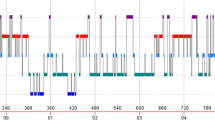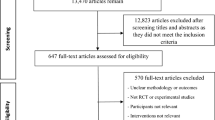Abstract
The aim of this study is to evaluate the clinical, electroencephalographic and polysomnographic features of patients presenting with parasomnias. Cases who were admitted for differentiating parasomnias from epilepsy were included in the study. Clinical features of cases were recorded and routine sleep electroencephalography was obtained from all cases. Cases whose symptoms strongly suggested nocturnal seizure underwent all night video electroencephalography monitoring. Polysomnography was obtained to evaluate the quality of breathing from patients whose symptoms suggested obstructive sleep apnea. Twenty-three patients with no neurological disorder were included in the study. The mean age of the patients was 11.7 ± 2.8 [7–17] years. Twelve patients (52 %) presented with sleep terrors and 11 patients (48 %) presented with sleep walking. All of the patients underwent a routine sleep electroencephalographic study and 15 patients (65 %) whose symptoms strongly suggested nocturnal epilepsy underwent long-term video electroencephalographic evaluation. Ten patients (43 %) underwent polysomnographic study. Three patients (20 %) who underwent long-term video electroencephalographic evaluation were diagnosed to have nocturnal frontal lobe epilepsy and two patients (20 %) who underwent polysomnography had pathological sleep apnea. Eleven patients (48 %) had a psychiatric disorder like major depression, anxiety disorder, hyperactivity disorder and obsessive–compulsive disorder. Childhood cases presenting with parasomnias should be searched for nocturnal epileptic disorders, sleep disordered breathing and psychiatric disorders.
Similar content being viewed by others
References
American Sleep Disorders Association (1997) Internal classification of sleep disorders, revised: diagnostic and coding manual. American Sleep Disorders Association, Rochester
Mehlenbeck R, Spirito A, Owens J, Boergers J (2000) The clinical presentation of childhood partial arousal parasomnias. Sleep Med 1:307–312
Wiggs LD (2003) Pediatric sleep disorders: the need for multidisciplinary sleep clinics. Int J Ped Otorhinolaryngol 67:115–118
Lewin DS, Rosen RC, England SJ, Dahl RE (2002) Preliminary evidence of behavioural and cognitive sequelae of obstructive sleep apnea in children. Sleep Med 3:15–18
Gozal D (1998) Sleep disordered breathing and school performance in children. Pediatrics 102:616–620
Petit D, Touchette E, Tremblay RE et al (2007) Dyssomnias and parasomnias in early childhood. Pediatrics 119:1016–1025
Kotagal S (2008) Parasomnias of childhood. Curr Opin Pediatr 20:659–665
Bruni O, Ferri R, Novelli L et al (2008) NREM sleep instability in children with sleep terrors: the role of slow wave interruptions. Clin Neurophysiol 119:985–992
Klackenberg G (1987) Incidence of parasomnias in children in a general population. In: Guilleminault C (ed) Sleep and its disorders in children. Raven Press, New York, pp 99–113
Guilleminault C, Palombini L, Pelayo R, Chervin RD (2003) Sleep walking and sleep terrors in prepubertal children: what triggers them? Pediatrics 111:e17–e25
Sheldon SH (2004) Parasomnias in childhood. Pediatr Clin N Am 51:69–88
Kotagal S (2009) Parasomnias of childhood. Sleep Med Rev 13:157–168
Kales A, Soldatos CR, Bixler BO et al (1980) Hereditary factors in sleep walking and night terrors. Br J Psychiatry 137:111–118
Abe K, Amatomi M, Oda N (1984) Sleep walking and recurrent sleep talking in children of childhood sleep walkers. Am J Psychiatry 141:800–801
Nguyen BH, Perusse D, Paquet J et al (2008) Sleep terrors in children: a prospective study of twins. Pediatrics 122:e1164–e1167
Goodwin JL, Kaemingk KL, Fregosi RF et al (2004) Parasomnias and sleep disordered breathing in Caucasian and Hispanic children—the Tucson children’s assessment of sleep apnea study. BMC Med 2:14
Espa F, Dauvilles Y, Ondze B, Billiard M, Besset A (2002) Arousal reactions in sleepwalking and night terrors in adults: the role of respiratory events. Sleep 25:871–875
Dahl RE (1996) The impact of inadequate sleep on children’s daytime cognitive function. Semin Pediatr Neurol 3:44–50
Lavigne JV, Arend R, Rosenbaum D et al (1999) Sleep and behavior problems among preschoolers. J Dev Behav Pediatr 20:164–169
Sadeh A, Gruber R, Raviv A (2002) Sleep, neurobehavioral functioning, and behavior problems in school-age children. Child Dev 73:405–417
Owens J, Maxim R, Nobile C et al (2000) Parental and self-report of sleep in children with attention-deficit/hyperactivity disorder. Arch Pediatr Adolesc Med 154:549–555
Liu X, Hubbard J, Fabes R, Adam J (2006) Sleep disturbances and correlates of children with autism spectrum disorders. Child Psychiatry Hum Dev 37:179–191
Conflict of interest
None.
Author information
Authors and Affiliations
Corresponding author
Rights and permissions
About this article
Cite this article
Yiş, U., Kurul, S.H., Öztura, İ. et al. Polysomnographic and long-term video electroencephalographic evaluation of cases presenting with parasomnias. Acta Neurol Belg 113, 285–289 (2013). https://doi.org/10.1007/s13760-012-0156-4
Received:
Accepted:
Published:
Issue Date:
DOI: https://doi.org/10.1007/s13760-012-0156-4




